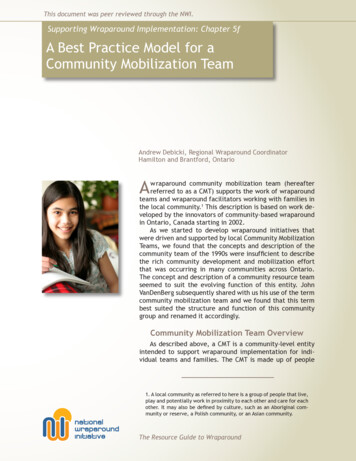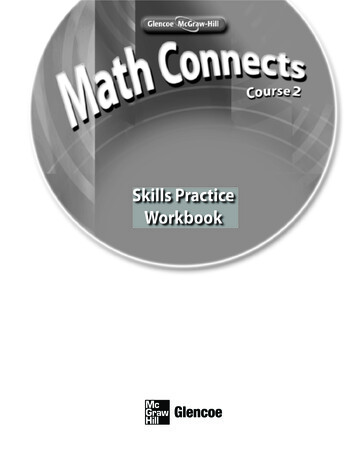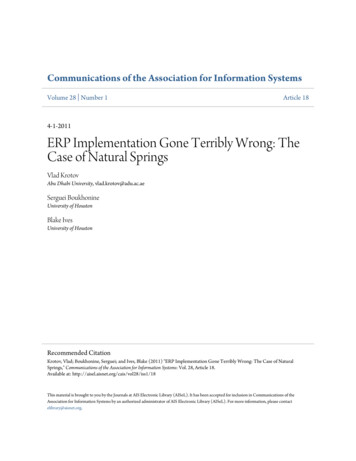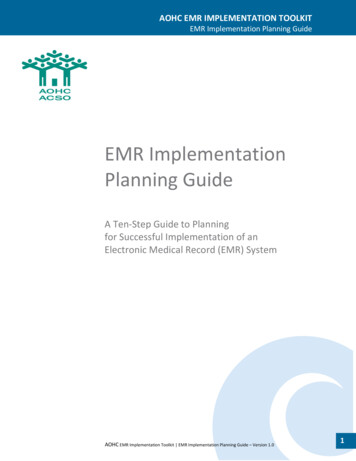
Transcription
This document was peer reviewed through the NWI.Supporting Wraparound Implementation: Chapter 5fA Best Practice Model for aCommunity Mobilization TeamAndrew Debicki, Regional Wraparound CoordinatorHamilton and Brantford, OntarioAwraparound community mobilization team (hereafterreferred to as a CMT) supports the work of wraparoundteams and wraparound facilitators working with families inthe local community.1 This description is based on work developed by the innovators of community-based wraparoundin Ontario, Canada starting in 2002.As we started to develop wraparound initiatives thatwere driven and supported by local Community MobilizationTeams, we found that the concepts and description of thecommunity team of the 1990s were insufficient to describethe rich community development and mobilization effortthat was occurring in many communities across Ontario.The concept and description of a community resource teamseemed to suit the evolving function of this entity. JohnVanDenBerg subsequently shared with us his use of the termcommunity mobilization team and we found that this termbest suited the structure and function of this communitygroup and renamed it accordingly.Community Mobilization Team OverviewAs described above, a CMT is a community-level entityintended to support wraparound implementation for individual teams and families. The CMT is made up of people1. A local community as referred to here is a group of people that live,play and potentially work in proximity to each other and care for eachother. It may also be defined by culture, such as an Aboriginal community or reserve, a Polish community, or an Asian community.The Resource Guide to Wraparound
Section 5: Supporting Wraparound Implementationwho are “community connectors.” John McKnight,Professor of Education and Social Policy and CoDirector of the Asset-Based Community Development Institute at Northwestern University, hasidentified the primary characteristics of good“community connectors” as follows:1. They are gift centered in their nature.2. They are well connected in their community. . They are trusted—this is important because they are asking people to help families with children and youth with complexneeds who are often marginalized andhave become isolated from positive socialnetworks. . They believe that their community is awelcoming and supportive community.Community connectors come from all walksof life. Frequently, they are community leaders,representatives from natural or informal community support entities (such as recreation, faith,business, or service clubs), or representatives offormal child and family services in the community. The important role they play is to help thefamilies served through the local initiative to getconnected to volunteer support people and inkind resources they require to have their needsaddressed on a daily basis.The chair of a CMT is often a locally recognizedcommunity leader and/or champion for childrenand families. The CMT functions in a manner simi- lar to but distinct from a steering or advisory committee or a board of directors. Lead agencies takecare of all the programmatic and administrativeaspects of the functioning of the CMT.There are several main purposes of the CMT: To educate the local community aboutwraparound and the children, youth, andfamilies who participate; To mobilize the community and its resources and volunteers to provide effectivecommunity support to each family withchildren and youth with complex needsinvolved in wraparound that live in thatcommunity; and To support the work of wraparound facilitators by connecting the children, youth,and families served to the in-kind resourcesand volunteers they require to meet theirneeds on a daily basisHere are a few examples of how effectivecommunity supports may be facilitated by a CMT:1. A young mother in her late teens with twochildren got her life back together withthe help of wraparound. She had bouncedfrom foster home to foster home and thengroup home to group home from ages 4to 16 when she left her last group home.All together, she had been in 23 differentplacements. She believed that parentingwas instinct as she had not experienced apositive parenting experience herself. As ayoung mother of two children she was anopen case to child welfare because theywere concerned about her low level ofparenting skills. When she had completeda very successful year in wraparound thatsaw child welfare close her file, she wasasked what about wraparound had madethe biggest difference. To her, it was thevolunteer mentor who helped her developher parenting skills. The mentor was recruited for her early in her wraparoundprocess by the CMT.2. A man and a woman with three childrenhad been on disability for the last 12years. Upon doing the strengths discovery,
Chapter 5f: Debickithe wraparound facilitator identified thatthe father had grown up in a family andtown where it was important for him tolearn to fix his own car. The father hadonly worked in food services at minimumwage before being put on disability. Withthe help of the local CMT, the father wassponsored to get his mechanics certificate.A person on the CMT used their connections at a local garage to get them to givethe father a shot at being an apprentice.Not only did he complete his apprenticeship, but he was also hired on as a mechanic by the garage once he was finishedhis apprenticeship.3. A teenage boy of 14 just about to be released from secure custody was referred towraparound. Upon meeting him, his wraparound facilitator discovered that despiteexhibiting extreme acting-out behavior inthe custody facility, he was enthusiasticabout all outdoor sports and some indoorsports and could quote stats for the lastfive years about sports such as hockey, biking, and skiing. With the help of the localCMT, he was placed for his court-orderedrestitution at an outdoor sporting goodsstore that a CMT member frequented. Initially, the manager of the store requesteda one-to-one worker to be with the 14year-old all the time. Within a week, themanager phoned the probation officer andsaid that the one-to-one worker was notneeded. He said that the youth’s passionfor outdoor sports was such that he hadswitched the young man from doing oddjobs to selling sports equipment. The manager predicted that he would be a greatsalesman for him.A Vision and Mission forDeveloping CMTsOur vision is a vibrant network of localizedcommunity mobilization teams, linked togetheracross the country, providing effective communitysupport for local families with children, youth, oradults with multiple, complex problems involvedin wraparound.Our mission is to continue to develop andlaunch a number of localized CMTs across Canada over the coming years. Each of these CMTswill mobilize their local community by securingthe necessary financial and in-kind resources andsupport so that families with children, youth, oradults with complex needs involved with wraparound can receive effective community support.Engaging Potential Members of a CMTPeople we approach to be on the CMT oftenask us how this community group we are askingthem to join (and possibly lead) helps children,youth and adults and their families dealing withcomplex needs, and how wraparound is differentfrom other services. To answer these questions,we first try to explain wraparound in a community-friendly way, providing an example of how itworks.For example, a referred family with children, youth or adults with complex needs is assigned a wraparound facilitator whose role is towork in partnership with the family to help thempull together their wraparound team. This teamwill be made up of the family themselves, theirfriends, community support people, and the service providers involved with the family that theyfind helpful. This is the family’s team. They decide who will be on their team. The facilitatorworks with the family to help them identify theirstrengths, their culture and their priority needs.The facilitator and the family then bring togetherthe family’s wraparound team and together theyreview the strengths, culture and needs with theteam and get them to add to each.The facilitator then helps the family and theirteam to work through a highly structured, intenseplanning process. The product of this planning isthe development of a comprehensive plan thataddresses the top one or two needs that the family has chosen. This is accomplished by the facilitator helping the team brainstorm strategies thatbuild on the strengths of the family, their team,and the community in which they live. The familythen chooses the strategies that they think willwork best. In essence, this team “wraps” servicesand supports around the family, based on theirdescription of what is needed and what mightwork.The potential CMT member is told that their
Section 5: Supporting Wraparound Implementationrole will be to participate on a team that mobilizes the community to acquire necessary resources for participating families and teams. Suchneeds are communicated (in a non identifying wayto the family) to the members of the local CMTthrough formal and informal channels. Resourcesmay include volunteer and/or in-kind donationsthat are beyond the resources of the family andtheir team.What makes wraparound so different? Inresponse to questions about how wraparound isdifferent from other service models, we typicallypresent these four examples:1. The family’s wraparound team brings together the family’s friends and relatives,community support people and the serviceproviders that the family finds helpful. Thewraparound planning process integratesall of their efforts to help create a singleplan for the family, focusing on one or twopriorities identified by the family. Whilesafety issues are non-negotiable, familiesusually identify safety issues as their toppriority.2. Part of the role of the wraparound facilitator is to teach the youth and family to buildtheir capacity to do this kind of planningfor themselves wherever possible. Manyfamilies graduate from the wraparoundprocess and are able to carry on their ownwraparound planning. . The CMT is able to help find the in-kind resources and volunteers that the family andtheir wraparound team need, but are notable to immediately obtain. . The family’s wraparound team and the local community mobilization team are connected to help the family rebuild its safetynet, develop connections to positive socialnetworks, and develop positive relationships over time with people in their localcommunity.Youth and parents who have been involved withthe wraparound process talk about wraparound asbeing different and providing them with real hopethat life could be better on a daily basis. The Structure and Functioning of aCommunity Mobilization TeamJohn McKnight strongly recommended to usthat the relationship or partnership between childand family services and our CMTs be structuredsuch that the child and family service providerssupport local community leaders and citizens inthat community to be in charge of the CMT.All members of the CMT sign a partnershipagreement that clearly outlines the role and functioning of a CMT and what is expected of eachmember. Agreements signed by sponsoring agencies also address due diligence issues, such asvolunteer clearance and supervision and liabilityinsurance.So, is the structure and functioning of a CMTlike a board of directors, an advisory or steering committee, or a community service club? ACMT functions a little like each one of these typesof entities. Like a board of directors, it overseesthe acquisition and use of in-kind resources andvolunteers. The CMT also has an executive like aboard of directors, though typically not with staffper se. A CMT also functions a little like an advisory or steering committee in that it providesfeedback to the local wraparound initiative. However, the members of the CMT have actual dutieslinked to the functions of a CMT described in thepreceding section.Finally, a CMT functions like a communityservice club in that it attracts people to a groupthat strongly believes in the power of the localcommunity to do good things for those in needin their community. However, while similar, thefocus on mobilizing the community into a state ofreadiness or preparedness to help address the individual needs of families with children, youth oradults with multiple, complex problems involvedin wraparound is more like a board of directors.Expectations for Members of aCommunity Mobilization Team1. Members are passionate about helpingfamilies with children, youth and adultsin their community, especially when theirneeds are complex and hard to address.2. Members are oriented to and willing tosupport what wraparound is and how it
Chapter 5f: Debickihelps families with children, youth andadults with complex needs have a betterlife. They are also asked to commit to thevision and mission described above. . Members are oriented to and willing tosupport what a CMT is and how it helps, aswell as committed to work in accordancewith the personal values and the community principles that underpin how wraparound is provided to people and familiesin need in the local community. . Members are asked to give what they canin the way of their own gifts, strengths andresources to support the function of theCMT and the people and families in wraparound that live in that local community.5. Members are asked to act as “communityconnectors” to other individuals and socialnetworks that have in kind resources andvolunteers that could potentially help orbe needed by people and families involvedin wraparound that live in that local community.We suggest to people that minimally it will involve one 2-3 hour meeting per month. They alsowill be asked to use their “connections” to helpfind in kind resources and potential volunteers,which they should be able to do in the course oftheir regular activities through the week. In addition, members may chose to get more involvedand join a particular subcommittee (e.g. publiceducation or fundraising) which would add another two hours to what they do in a month for aboutfive hours at most. Or, they may choose to runfor a position on the Executive next time there isan opening, which would potentially add anothertwo hours monthly.The Structure of a CMTAs shown in Figure 1 (see page 6), the CMTis conceived as supporting individual families andtheir wraparound teams. This support is providedin partnership with sponsoring agencies who implement wraparound. These agencies also provideadministrative support to the CMT. Below we provide a description of the key roles in the functioning of a CMT.Executive Team. Each CMT has an executive team as well as a chair or multiple co-chairswho direct the executive team and provide leadership andmanagement of a local CMT. The execuYouth andtive team administersthe CMT partnershipparents whoagreement with bothhave beenthe membership ofinvolved withthe CMT and with thesponsoring agenciesthe wraparoundthat provide adminprocess talk aboutistrative support forwraparound asthe CMT and providewraparoundfacilibeing different andtators to work withproviding themfamilies. An executive team may alsowith real hopehave subcommitteesthat life could besuch as public relabetter on a dailytions, fundraising andmembership recruitbasis.ment for the CMT. Theexecutive team takesa lead role in community mobilization ofin kind resources andvolunteers (e.g. drivers, tutors, coaches, mentors, etc.)Chair or Co Chairs of the CMT. As describedabove, ideally the CMT chair or co-chairs are people who are already viewed as community champions. The chair(s) are critical to success of the CMTand the wraparound initiative. The chair(s) workwith the support of the sponsoring agencies to ensure that all people, including those on the CMTand others involved with the local wraparound initiative, work together to ensure the smooth functioning of the initiative.Wraparound Teams. As described in more detail above and in this Resource Guide, wraparoundteams consist of people supporting individualfamilies with whom wraparound is being implemented. A facilitator helps the family to identifypotential team members and then uses the following guidelines to select the people to be ontheir team: Is the person willing to help? Does the family generally trust their advice?
Section 5: Supporting Wraparound ImplementationFigure 1. The Role of a Community Mobilization Team in Supporting ilization TeamRequests for In-KindResources or VolunteersSubcommittees(e.g., Publicity,Fundraising)WRAP FACILITATORFAMILYFAMILY TEAMSponsoring AgenciesProviding Wraparoundand AdministrativeSupport to CMTs Is the person generally a positive influencewith the family? Will the person keep the family’s businessprivate and confidential?Sponsoring Agencies. In addition to overseeing implementation of wraparound and supervision of staff such as the wraparound facilitators,sponsoring agencies support local CMTs by takingcare of programmatic and legal functions, financial administration (hold and audit raised funds),and risk management (volunteer screening, liability insurance). They also provide meeting and office space, and provide charitable receipts asnecessary.Typical Agenda Items and RelatedDiscussion for a Meeting of the CMTLogistics. The meeting of the CMT is held ata time that is convenient for all members of theCMT. Supper meetings or meetings from 7-9 pmare popular times, as are lunchtime meetings. Thelocation of the meeting is meant to be welcoming. Typically it might be held at the chair’s houseor some other place such as a local restaurant ormeeting room that is warm and inviting. The chair
Chapter 5f: Debickiacts as host welcoming people and engaging themin conversation and easing them into the meeting.The chair always make sure that everybody knowseach other or gets to know each other. This partof the meeting may take up to 10 or 15 minutes oruntil the chair decides that everybody is comfortable.Celebrating Success. Typically the chair easesthe group into the meeting by describing themselves or getting the appropriate members to talkabout key areas of success since the last meeting.This is a time to celebrate and thank people fortheir efforts. Often this will include the announcement of the successful result of a search for a keyin kind resource or volunteer needed for a familyin wraparound. It is important that non identifying information about the family be used to alsotalk about how the receipt of the resource or thehelp of a volunteer is making a difference in thelives of the family in wraparound. Sometimes afacilitator attends to share success that the family has achieved, especially with respect to theresources and volunteers found by the CMT.Requests for Support. The chair then movesthe meeting into reviewing the requests for needed resources and volunteers by families involved inwraparound. Again, care is taken to keep the identity of the family confidential. If members thinkthat they can address the request themselves,then no further planning is required. However, ifthe request is beyond the resources immediatelyavailable to the members of the CMT, brainstorming a “fan out” strategy among everybody’s “community connections” may be called for. Once theideas are all out on the table, the top two or threeare chosen. Action plans are then developed andpeople volunteer to follow up on them so as toacquire the necessary resource or volunteer.It is important that the chair try to ensure thateverybody gets involved in both the brainstormingas well as the development of action plans. If amember goes to meeting after meeting withoutgetting or being involved in the work of the CMT,they often drop out of the CMT. In this respect wehave found that members who join the CMT wantto do things, not just talk about it. Members ofthe CMT say that they stay involved because theyfeel that their gifts and strengths are being valuedand used.Planning Educational and FundraisingEvents. The chair then asks people in chargeof educational and fundraising events to reviewwhere the planning is at, again trying to inviteothers to get involved as they choose.Closing and Setting the Next Meeting. Thechair then wraps up the meeting, summarizing anykey points that should be repeated before peopleleave, and ensuring that everybody is aware ofthe date and location of the next meeting. Usuallythere is a social period at the end of the meeting for those that don’t need to rush off to otherobligations.ReferencesMcKnight, J. (2007). Lectures on Asset-Based Community Development, St. Catharines & Hamilton: Ontario, Canada.AuthorAndrew Debicki, B.A., B.S.W., M.S.W., is the regional wraparound coordinator for Hamilton andBrantford, Ontario. He has been doing wraparoundsince 1993. Andrew is the co-chair of the Wraparound Association of Ontario and is working withWrap Canada to lead the development of wraparound across the country. He is also an externalpartner with Vroon VanDenBerg, LLP. Since 1996he has trained across Canada and more recentlyin Norway.This material is taken from training moduleswritten by Andrew Debicki as an external partnerof and for Vroon VanDenBerg LLP. The work in thismodule builds on original work done and writtenup by Andrew Debicki with Anne Bain.Suggested Citation:Debicki, A. (2008). A best practice modelfor a community mobilization team. In E.J. Bruns & J. S. Walker (Eds.), The resourceguide to wraparound. Portland, OR: National Wraparound Initiative, Research andTraining Center for Family Support and Children’sMental Health.
Community Mobilization Team A wraparound community mobilization team (hereafter referred to as a CMT) supports the work of wraparound teams and wraparound facilitators working with families in the local community.1 This description is based on work de-veloped by the innovators of commun










